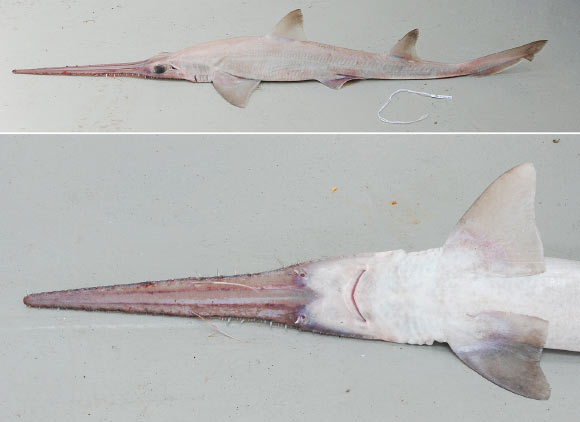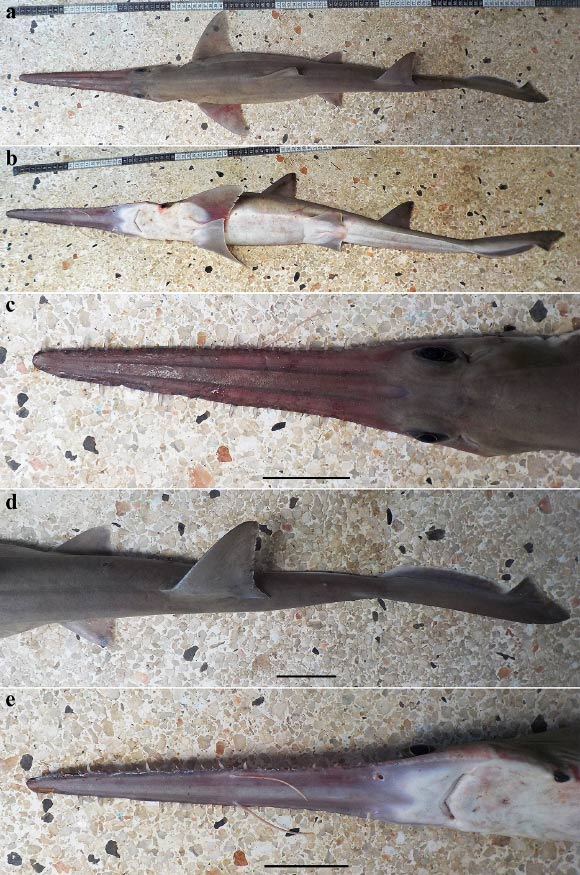A team of marine biologists has discovered two new species of six-gilled sawsharks living in the waters of the West Indian Ocean.

Pliotrema kajae, adult male, 97 cm total length. Image credit: Oddgeir Berg Alvheim, Institute of Marine Research, Bergen, Norway.
The sawshark is a type of shark best known for its saw-like snout.
Found mainly in the temperate waters of all three major oceans, with the center of distribution in the western Pacific Ocean, the number of sawsharks has declined in the past couple of decades due to commercial fishing.
These sharks can reach up to about 1.5 m in length and have a long snout edged with sharp teeth which alternate in size (smaller teeth are inserted between larger teeth).
They also have a distinctive pair of barbels in the middle of the snout — whisker-like sensory organs around the shark’s mouth which help the shark detect its prey.
Sawsharks are carnivores, living on a diet of fish, crustaceans and squid, and use their serrated snout to kill their prey. Fast movement of the snout from side to side cuts the prey into fine pieces that can be swallowed easily.
The two new sixgill sawshark species, named Pliotrema kajae and Pliotrema annae, were discovered during research investigating small-scale fisheries operating off the coasts of Madagascar and Zanzibar.
“The sixgill sawsharks are really quite extraordinary as most sawsharks have five gill slits per side,” said Dr. Simon Weigmann, a researcher in the Elasmobranch Research Laboratory at the University of Hamburg.
“So it was really exciting to find a new sixgill sawshark species and to find two new species — well that was simply astonishing!”

Pliotrema annae, presumably adult female, 98 cm total length. Scale bars – 5 cm. Image credit: Oddgeir Berg Alvheim, Institute of Marine Research, Bergen, Norway.
Individuals of Pliotrema kajae, also known as the Kaja’s sixgill sawshark, were identified originating from Madagascar and the Mascarene Ridge.
Specimens of Pliotrema annae, also known as the Anna’s sixgill sawshark, were only found off Zanzibar.
Pliotrema kajae appears to inhabit upper insular slopes and submarine ridges at depths of 214-320 m, Pliotrema annae so far is only known from shallow waters (20-35 m).
Both new species differ from the only previously known sixgill species, Pliotrema warreni, in the position of their barbells.
In Pliotrema kajae and Pliotrema annae, these are situated approximately half way from the tip of the saw — the rostral tip — to the mouth, compared to Pliotrema warreni, where they are about two thirds of the way down, much closer to the mouth.
A special feature of Pliotrema annae is the generally shorter rostrum as compared to Pliotrema kajae and Pliotrema warreni.
“Knowledge of sawsharks in the western Indian Ocean is generally still scarce. But considering their known depth distributions, both new species are likely affected by fishing operations,” Dr. Weigmann said.
“This assumption, combined with the limited range and apparent rarity of both new species, raises concerns that they are vulnerable to overfishing and might be in continuing decline.”
“This could be particularly alarming for the Anna’s sixgill sawshark due to its very small known range, rarity and occurrence in shallow waters as the species is only known from depths of 20 to 35 m.”
The discovery is described in a paper in the journal PLoS ONE.
_____
S. Weigmann et al. 2020. Revision of the sixgill sawsharks, genus Pliotrema (Chondrichthyes, Pristiophoriformes), with descriptions of two new species and a redescription of P. warreni Regan. PLoS ONE 15 (3): e0228791; doi: 10.1371/journal.pone.0228791







